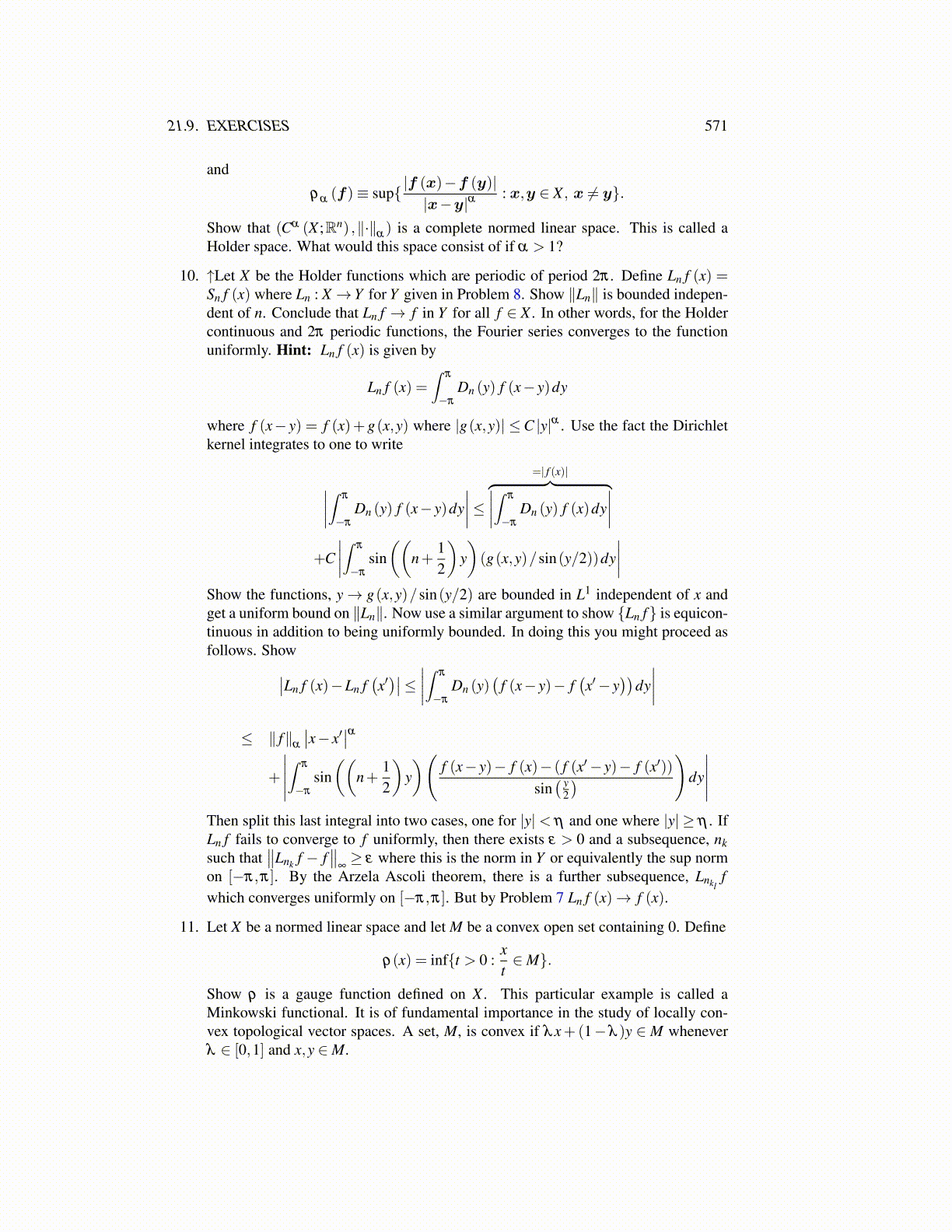
21.9. EXERCISES 571
and
ρα (f)≡ sup{ |f (x)−f (y)||x−y|α
: x,y ∈ X , x ̸= y}.
Show that (Cα (X ;Rn) ,∥·∥α) is a complete normed linear space. This is called a
Holder space. What would this space consist of if α > 1?
10. ↑Let X be the Holder functions which are periodic of period 2π . Define Ln f (x) =Sn f (x) where Ln : X →Y for Y given in Problem 8. Show ∥Ln∥ is bounded indepen-dent of n. Conclude that Ln f → f in Y for all f ∈ X . In other words, for the Holdercontinuous and 2π periodic functions, the Fourier series converges to the functionuniformly. Hint: Ln f (x) is given by
Ln f (x) =∫
π
−π
Dn (y) f (x− y)dy
where f (x− y) = f (x)+g(x,y) where |g(x,y)| ≤C |y|α . Use the fact the Dirichletkernel integrates to one to write
∣∣∣∣∫ π
−π
Dn (y) f (x− y)dy∣∣∣∣≤
=| f (x)|︷ ︸︸ ︷∣∣∣∣∫ π
−π
Dn (y) f (x)dy∣∣∣∣
+C∣∣∣∣∫ π
−π
sin((
n+12
)y)(g(x,y)/sin(y/2))dy
∣∣∣∣Show the functions, y→ g(x,y)/sin(y/2) are bounded in L1 independent of x andget a uniform bound on ∥Ln∥. Now use a similar argument to show {Ln f} is equicon-tinuous in addition to being uniformly bounded. In doing this you might proceed asfollows. Show∣∣Ln f (x)−Ln f
(x′)∣∣≤ ∣∣∣∣∫ π
−π
Dn (y)(
f (x− y)− f(x′− y
))dy∣∣∣∣
≤ ∥ f∥α
∣∣x− x′∣∣α
+
∣∣∣∣∣∫
π
−π
sin((
n+12
)y)(
f (x− y)− f (x)− ( f (x′− y)− f (x′))sin( y
2
) )dy
∣∣∣∣∣Then split this last integral into two cases, one for |y|< η and one where |y| ≥ η . IfLn f fails to converge to f uniformly, then there exists ε > 0 and a subsequence, nksuch that
∥∥Lnk f − f∥∥
∞≥ ε where this is the norm in Y or equivalently the sup norm
on [−π,π]. By the Arzela Ascoli theorem, there is a further subsequence, Lnklf
which converges uniformly on [−π,π]. But by Problem 7 Ln f (x)→ f (x).
11. Let X be a normed linear space and let M be a convex open set containing 0. Define
ρ(x) = inf{t > 0 :xt∈M}.
Show ρ is a gauge function defined on X . This particular example is called aMinkowski functional. It is of fundamental importance in the study of locally con-vex topological vector spaces. A set, M, is convex if λx+(1−λ )y ∈M wheneverλ ∈ [0,1] and x,y ∈M.